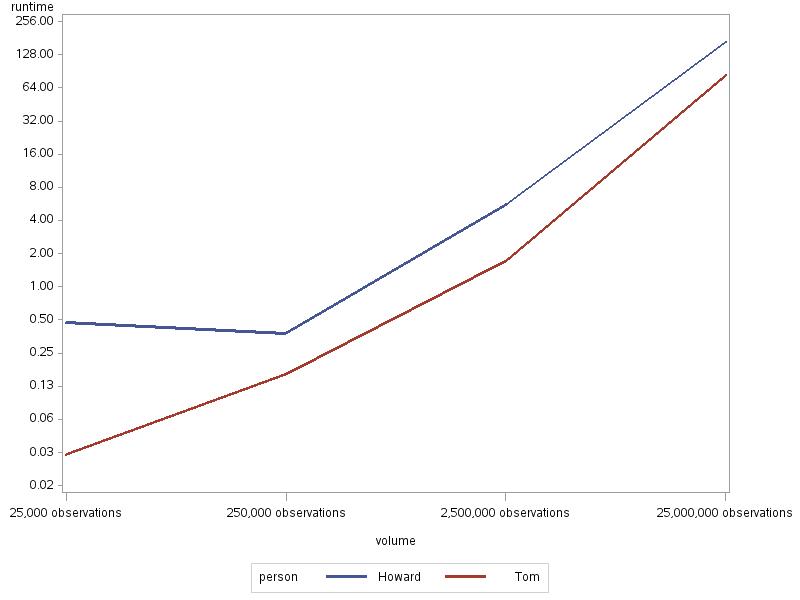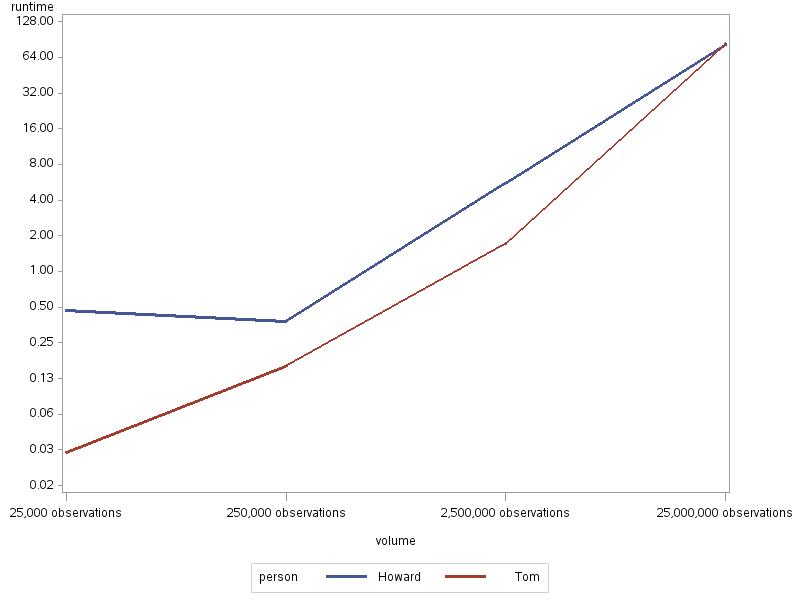- Home
- /
- Programming
- /
- SAS Procedures
- /
- Re: How can I combine 2 columns into one?
- RSS Feed
- Mark Topic as New
- Mark Topic as Read
- Float this Topic for Current User
- Bookmark
- Subscribe
- Mute
- Printer Friendly Page
- Mark as New
- Bookmark
- Subscribe
- Mute
- RSS Feed
- Permalink
- Report Inappropriate Content
I would like to combine columns into one. But i don't know how to do so. My data set is like this:
Period ColA ColB ColC
1 1
1 2
1 3
2 1
2 2
3 5
3 8
And i would like to combine the same column of period into one. like this:
Period ColA ColB ColC
1 1 2 3
2 1 2
3 5 8
i have tried many times but it still doesn't work.
- Mark as New
- Bookmark
- Subscribe
- Mute
- RSS Feed
- Permalink
- Report Inappropriate Content
There is probably a more efficient way of doing what you want, but the following will accomplish the task:
data have;
input Period ColA ColB ColC;
cards;
1 1 . .
1 . 2 .
1 . . 3
2 1 . .
2 . 2 .
3 5 . .
3 . . 8
;
data firstonly;
set have;
by Period;
if first.Period;
run;
data want;
update firstonly have;
by Period;
run;
- Mark as New
- Bookmark
- Subscribe
- Mute
- RSS Feed
- Permalink
- Report Inappropriate Content
You can use the UPDATE statement. This will take the last non-missing value for each variable. It wants a master table and an update table, but you can just use OBS=0 to have it start with an empty master table.
data have ;
input Period ColA ColB ColC @@;
cards;
1 1 . . 1 . 2 . 1 . . 3 2 1 . . 2 . 2 . 3 5 . . 3 . . 8
run;
data want ;
update have(obs=0) have ;
by period;
run;
data _null_;
set want;
put (_All_) (:) ;
run;
1 1 2 3
2 1 2 .
3 5 . 8
- Mark as New
- Bookmark
- Subscribe
- Mute
- RSS Feed
- Permalink
- Report Inappropriate Content
And in SQL:
PROC SQL;
CREATE TABLE WANT AS
SELECT Period,
(MAX(ColA)) AS ColA,
(MAX(ColB)) AS ColB,
(MAX(ColC)) AS ColC
FROM HAVE
GROUP BY Period;
QUIT;
Tom
- Mark as New
- Bookmark
- Subscribe
- Mute
- RSS Feed
- Permalink
- Report Inappropriate Content
proc summary data=have nway ;
class period ;
var col: ;
output out=want(drop = _type_ _freq_) mean= ;
run ;
- Mark as New
- Bookmark
- Subscribe
- Mute
- RSS Feed
- Permalink
- Report Inappropriate Content
: Definitely an interesting way to do it but, from my test, Tom's method runs almost twice as fast. I ran:
/* Create some sample data */
data have (drop=_:);
input _Period ColA ColB ColC;
do Period=_Period to _Period+999;
output;
end;
cards;
1 1 . .
1 . 2 .
1 . . 3
1001 1 . .
1001 . 2 .
2001 5 . .
2001 . . 8
3001 1 . .
3001 . 2 .
3001 . . 3
4001 1 . .
4001 . 2 .
5001 5 . .
5001 . . 8
6001 1 . .
6001 . 2 .
7001 5 . .
7001 . . 8
8001 1 . .
8001 . 2 .
8001 . . 3
9001 1 . .
9001 . 2 .
10001 5 . .
10001 . . 8
;
proc sort data=have;
by period;
run;
/*Howard's suggested code*/
proc summary data=have nway ;
class period ;
var col: ;
output out=want(drop = _type_ _freq_) mean= ;
run ;
/*Tom's suggested code*/
data want ;
update have(obs=0) have ;
by period;
run;
- Mark as New
- Bookmark
- Subscribe
- Mute
- RSS Feed
- Permalink
- Report Inappropriate Content
This should run as quickly as Tom's SQL, I hope (although it is more verbose!):
data lastonly (drop=t_:);
set have (rename=(ColA=t_A ColB=t_B ColC=t_C));
by Period;
length ColA ColB ColC 8.;
retain ColA ColB ColC;
if first.Period then do;
ColA = .;
ColB = .;
ColC = .;
end;
ColA = max(ColA,t_A);
ColB = max(ColB,t_B);
ColC = max(ColC,t_C);
if last.Period then output;
run;
- Mark as New
- Bookmark
- Subscribe
- Mute
- RSS Feed
- Permalink
- Report Inappropriate Content
I love Tom's solution (never seen that pattern before), but I'm also a big fan of PROC SUMMARY/MEANS. I was wondering if procedure startup code explained the time differences, so I ran some tests at higher volumes. Note that the times for "Tom" include a sort, as it is required for his pattern, whereas the SUMMARY doesn't need to be sorted. The times were:
Summary Tables
| Howard | Tom | |||
|---|---|---|---|---|
| volume | Real Time | CPU Time | Real Time | CPU Time |
| 25,000 observations | 0:00.47 | 0:00.21 | 0:00.03 | 0:00.02 |
| 250,000 observations | 0:00.38 | 0:00.51 | 0:00.16 | 0:00.28 |
| 2,500,000 observations | 0:05.54 | 0:07.17 | 0:01.71 | 0:02.84 |
| 25,000,000 observations | 2:46.00 | 2:06.00 | 1:23.00 | 0:41.00 |
Generated by the SAS System ('Local', X64_7PRO) on
November 26, 2012 at 4:26:14 PM
And as a chart:

Howver, the 25 million row with SUMMARY run required disk work space, so I reran it with increased memsize. Here's the result:

Note the vertical scale is log.
So:
Tom's technique is as efficient as it gets;
PROC SUMMARY will somewhat catch up at higher volumes, but requires more memory;
I just blew a whole afternoon, and enjoyed every bit of it!
Tom
- Mark as New
- Bookmark
- Subscribe
- Mute
- RSS Feed
- Permalink
- Report Inappropriate Content
It depends on what answer you want. Using the UPDATE statement will take the last non-missing value. Calculating a statistic such MEAN, MIN or MAX could get a different answer when there are multiple non-missing values of a variable within the same by group.
- Mark as New
- Bookmark
- Subscribe
- Mute
- RSS Feed
- Permalink
- Report Inappropriate Content
Here is another approach, although not quite sure how efficient that would be:
data _null_;
if(1=2) then set have;
declare hash cols(ordered:"a");
cols.defineKey("period");
cols.defineData("period","colA", "colB", "colC");
cols.defineDone();
do until(done);
set have end=done;
x1=colA; x2=colB; x3=colC;
rc1=cols.find();
y1=max(x1, colA); y2=max(x2, colB); y3=max(x3, colC);
rc2=cols.replace(key:period,data:period,data:y1,data:y2,data:y3);
end;
cols.output(dataset:"want");
stop;
run;
RESULTS:
| Period | ColA | ColB | ColC | |
|---|---|---|---|---|
| 1 | 1 | 1 | 2 | 3 |
| 2 | 2 | 1 | 2 | . |
| 3 | 3 | 5 | . | 8 |
- Mark as New
- Bookmark
- Subscribe
- Mute
- RSS Feed
- Permalink
- Report Inappropriate Content
- Mark as New
- Bookmark
- Subscribe
- Mute
- RSS Feed
- Permalink
- Report Inappropriate Content
Wow! Many thanks, Tom.
Will keep that in mind.
Kind regards,
Joe
- Mark as New
- Bookmark
- Subscribe
- Mute
- RSS Feed
- Permalink
- Report Inappropriate Content
Actually, I suggested another approach...but I don't have time to time it ![]()
- Mark as New
- Bookmark
- Subscribe
- Mute
- RSS Feed
- Permalink
- Report Inappropriate Content
April 27 – 30 | Gaylord Texan | Grapevine, Texas
Registration is open
Walk in ready to learn. Walk out ready to deliver. This is the data and AI conference you can't afford to miss.
Register now and lock in 2025 pricing—just $495!
Learn the difference between classical and Bayesian statistical approaches and see a few PROC examples to perform Bayesian analysis in this video.
Find more tutorials on the SAS Users YouTube channel.
SAS Training: Just a Click Away
Ready to level-up your skills? Choose your own adventure.



